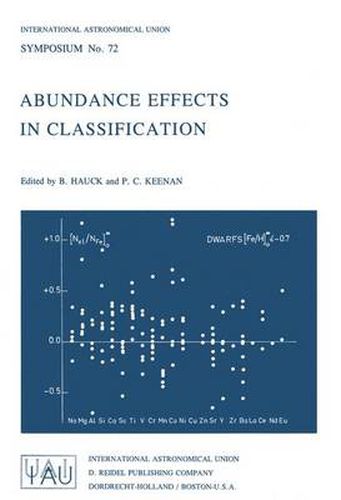Readings Newsletter
Become a Readings Member to make your shopping experience even easier.
Sign in or sign up for free!
You’re not far away from qualifying for FREE standard shipping within Australia
You’ve qualified for FREE standard shipping within Australia
The cart is loading…






This title is printed to order. This book may have been self-published. If so, we cannot guarantee the quality of the content. In the main most books will have gone through the editing process however some may not. We therefore suggest that you be aware of this before ordering this book. If in doubt check either the author or publisher’s details as we are unable to accept any returns unless they are faulty. Please contact us if you have any questions.
The general discussions of the roles of photometric and spectroscopic classification at Cordoba in 1971 (lAU Symposium No. 50), and of the calibration of classification indices at Geneva in 1972 (IAU Symposium No. 54), revealed clearly the steadily in creasing importance of abundance parameters. The multipliCity of these, however, raised so many new problems that it was logical that the 1975 meeting at Lausanne should be concerned with ways in which differences in abundance affect both spectral types and photometric indices. Commissions 29 and 36 joined with Commission 45 in sponsoring this Symposium. Since the date of the meeting came shortly after the formal retirement of Professor William W. Morgan from the University of Chicago, it was quickly agreed that this meeting should be dedicated to him in recognition of his unique contributions to spectral classification. In the opening paper of the Symposium Dr. Bengt Stromgren has summarized these. To his remarks we should add only that it was about 1940 that Morgan first distinguished the group of G- and K-type stars with weak CN bands and metallic lines - stars which have since been recognized as having the abundance of all metals relative to hydrogen much lower than in stars of the solar population. Spectra of two of these, HD 81192 (Boss 2527) and 8 Lep, were later shown as examples of the group in the Yerkes Atlas of 1943.
$9.00 standard shipping within Australia
FREE standard shipping within Australia for orders over $100.00
Express & International shipping calculated at checkout
This title is printed to order. This book may have been self-published. If so, we cannot guarantee the quality of the content. In the main most books will have gone through the editing process however some may not. We therefore suggest that you be aware of this before ordering this book. If in doubt check either the author or publisher’s details as we are unable to accept any returns unless they are faulty. Please contact us if you have any questions.
The general discussions of the roles of photometric and spectroscopic classification at Cordoba in 1971 (lAU Symposium No. 50), and of the calibration of classification indices at Geneva in 1972 (IAU Symposium No. 54), revealed clearly the steadily in creasing importance of abundance parameters. The multipliCity of these, however, raised so many new problems that it was logical that the 1975 meeting at Lausanne should be concerned with ways in which differences in abundance affect both spectral types and photometric indices. Commissions 29 and 36 joined with Commission 45 in sponsoring this Symposium. Since the date of the meeting came shortly after the formal retirement of Professor William W. Morgan from the University of Chicago, it was quickly agreed that this meeting should be dedicated to him in recognition of his unique contributions to spectral classification. In the opening paper of the Symposium Dr. Bengt Stromgren has summarized these. To his remarks we should add only that it was about 1940 that Morgan first distinguished the group of G- and K-type stars with weak CN bands and metallic lines - stars which have since been recognized as having the abundance of all metals relative to hydrogen much lower than in stars of the solar population. Spectra of two of these, HD 81192 (Boss 2527) and 8 Lep, were later shown as examples of the group in the Yerkes Atlas of 1943.